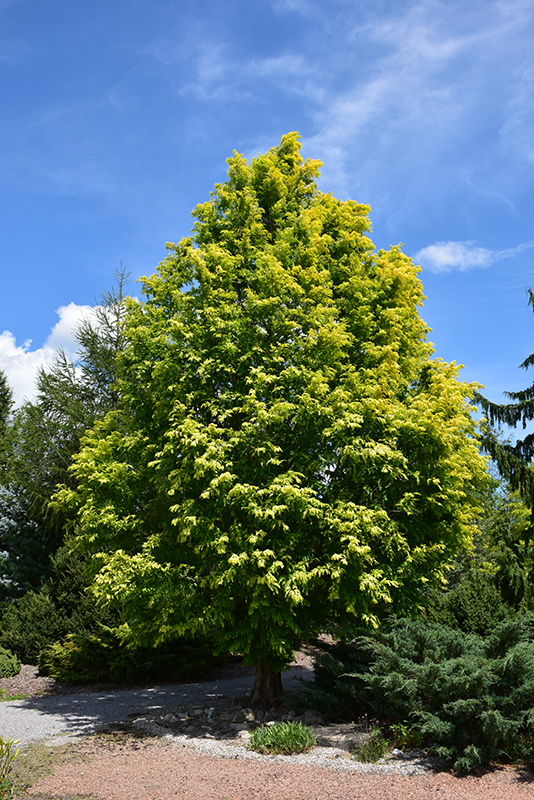Copyright Notice | Search | Home | Plant Gallery & Growing Guide | Shrubs and Trees

DAWN REDWOOD
Family: Cupressaceae
Pronounced: met-a-see-KWOY-ah glip-toe-stroe-BOY-deez
Quick Jumps
Growing Guide
Rainy Side Notes

GROWING GUIDE
Origin:
Garden.
Plant Group:
Conifers.
Hardiness:
Sunset zones: A3; 3-10.
USDA zones: 5-10.
Mature size:
Height 50+ feet (20+ m) in 20 years, eventually reaching 100 feet.
Width: 15-22 (5-7 m).
Cone attributes:
Pendulous cones 3/4 to 1 1/2-inches long and about 3/4-inch wide.
Needle attributes:
Needles are 1/2-inch long slightly curved, arranged opposite along the stem.
Growth habit:
Pyramidal.
Light:
Full sun.
Soil:
Moist, well-drained, slightly acidic soil.
Propagation Methods:
Softwood cuttings in summer.
Pests and Diseases:
None in the Pacific Northwest; I have not found any references to the tree having problems here.
Rainy Side Notes

Once thought to be extinct, Dawn redwood was discovered in 1944 in China, soon after million year old fossils from Metasequoias were found in Japan. This tree grew on the North American continent over 15 million years ago. Now, it is once again growing on this continent. Michael Dirr once wrote, 'This tree provides a case history of perhaps how endangered species should be managed. . . propagate and share.'
Metasequoia glyptostroboides 'Ogon' (Gold Rush) is a striking new addition to the extensive range of conifers supplied by specialist dwarf conifer grower, Lincluden Nursery of Bisley, Surrey, England. It was first reported by PLANTS at Chelsea Flower Show.
Gold Rush Dawn Redwood has attractive chartreuse foliage which emerges yellow in spring. The ferny bipinnately compound leaves are highly ornamental and turn an outstanding gold in the fall. Neither the flowers nor the fruit are ornamentally significant. The peeling indian red bark adds an interesting dimension to the landscape. Landscape Attributes. Metasequoia glyptostroboides 'Gold Rush' Metasequoia glyptostroboides 'Gold Rush' Common name: Gold Rush Dawn Redwood. Pronunciation: met-a-se-KWOY-a glip-to-stro-BOY. 'Gold Rush' - bright yellow foliage in spring and retains much of the color throughout the summer 'Miss Grace' - more or less ground sprawling, but if staked, a small tree with weeping branches State Fossil of Oregon: The Oregon legislature designated the Metasequoia as the official state fossil in 2005. 'Gold Rush' - bright yellow foliage in spring and retains much of the color throughout the summer 'Miss Grace' - more or less ground sprawling, but if staked, a small tree with weeping branches State Fossil of Oregon: The Oregon legislature designated the Metasequoia as the official state fossil in 2005.
Gold Rush Plant
Metasequoia glyptostroboides 'Gold Rush' was found as a seedling in Japan and was named 'Golden Ogi', which means the golden mantle. Dutch horticulturalist Peter Zweinburg brought it to Europe and changed the name to 'Gold Rush'.
The name, Metasequoia, comes from the Greek word meta, meaning changed and refers to sequoia, which it is related to.

This is a fast-growing tree, reaching 15-20 feet in ten years, after 20 or more years it will reach 50 feet. After that, it may reach 100 feet. It has not been in cultivation long enough for it to reach its full potential. In the Pacific Northwest, the gold foliage will not burn in full sun, unlike other gold foliage that has this tendency.
I found myself smitten with its fall coloring one day in the nursery. I went home to try to find room for just one more tree in my garden. I could plant it, but eventually it would outgrow the space I have available. Thankfully, my young friend, a beginning gardener who lives next door, bought one and planted it. So now I can enjoy the view of his tree from my back yard. I wonder, is he trying to show me up by planting a living relic in his backyard?
Metasequoia 'Gold Rush' keeps its coloring well into summer. It then turns orange-brown in fall, when it sheds its needles. In spring, the needles return an almost chartreuse yellow color. The bark is interesting on this deciduous tree, with deep fissures, giving it winter interest. It thrives in many kinds of soil. It is, however, important to give it some irrigation during our long summer drought. If you have room to grow this conifer, it will be a stunning addition to your landscape. Now if you will excuse me, I need to go negotiate myself some visiting rights for a tree next door.
Photographed at Savage Plants in Kingston, Washington.
Gardening for the Homebrewer: Grow and Process Plants for Making Beer, Wine, Gruit, Cider, Perry, and MoreBy co-authors Debbie Teashon (Rainy Side Gardeners) and Wendy Tweton
Metasequoia Glyptostroboides Gold Rush
Copyright Notice | Home | Search | Shrubs & Trees
